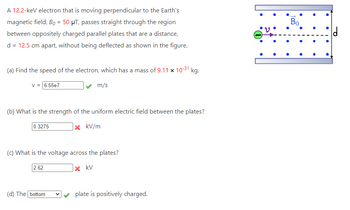Question

Transcribed Image Text:A 12.2-keV electron that is moving perpendicular to the Earth's
magnetic field, Bo = 50 μT, passes straight through the region
between oppositely charged parallel plates that are a distance,
d = 12.5 cm apart, without being deflected as shown in the figure.
31
kg.
(a) Find the speed of the electron, which has a mass of 9.11 × 10-³1 |
V = 6.55e7
m/s
(b) What is the strength of the uniform electric field between the plates?
0.3275
x kv/m
(c) What is the voltage across the plates?
2.62
x kv
(d) The bottom
V
plate is positively charged.
Bo
·
O
Expert Solution
This question has been solved!
Explore an expertly crafted, step-by-step solution for a thorough understanding of key concepts.
Step by stepSolved in 2 steps

Knowledge Booster
Similar questions
- 12.57×10-7 Tesla is not a valid option of the answers available to choose.arrow_forwardWhat is the z-component of the net force acting on a particle (so you can ignore gravity) of charge 467.4 uC moving at (437.9, -520.7, -526.6) m/s in an electric field = (4,778.8, -4,132.8, -4,712.2) N/C and a magnetic field = (-0.8, -0.7, 0.2) T? Assume that nothing is in contact with the charge.arrow_forwardDetermine the velocity of a beam of electrons that goes un-deflected when moving perpendicular to an electric and a magnetic field. E and B are also perpendicular to each other and have magnitudes 7.7 x103 V/m and 7.5x10-3T, respectively.arrow_forward
- What is the force acting on a 1.6(10)–19 C charge when it is moving at 3(10)7m/s perpendicular to a magnetic field whose strength is 0.02 T? What is the radius of the particle’s trajectory if the mass of the particle is 3.3(10)-27 kg?arrow_forwardPlease help me find the magnetic field of the regionsarrow_forward4+ 71. In Millikan's experiment, a potential difference of 2.0 is applied between the two plates, which are 8 mm apart, to balance an oil drop of mass 4.9 × 10-4 kg. Calculate the number of elementary charges on the drop (g = 10 m/s²). (7.6) m 106 mlo enters a 0.800 T. (8.2) TI (a) Determine the magnitude of the magnetic 101 exerted on the proton. (h) Dorcriho th tolro tho proton as it stays OFF /NO 2nd F CA MODE STAT VAR ALPHA SNI DEL SET UP RESET arc hypNOT sin1AND cos OR tan XOR DRGXNOR dhy sin COS DRG D 10 E A uj DEG STO Exp abc D°M'S DATA CD. -xy oy RANDOM re 6 sx*nPr ox CHEX CBINr ju 5. 2. 1. ANS 3. DECarrow_forward
- If an electron that’s entering a magnetic field B=2.0 with a velocity of V =2.0x10^7 m/s parallel to B experiences a magnetic force F b= ????arrow_forwardThe ions were accelerated by an applied voltage right before entering the magnetic field.What was the applied voltage if the ions accelerated from rest? V = ?arrow_forwardA 3.5 mC charge moves with a speed of 10,000 m/s in a magnetic field of 0.5 T. How much force is exerted on the charge?arrow_forward
arrow_back_ios
arrow_forward_ios